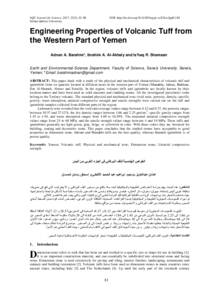وثيقة
Slope stability assessment and landslide susceptibility map production of Wadi Dhahr Area, Northwest of Sana’a, Yemen.
المعرف
DOI: http://dx.doi.org/10.24200/squjs.vol23iss2pp120-136
المصدر
Sultan Qaboos University Journal for Science. v. 29, no. 3, p. 120-136.
المساهمون
Khanbari, Khaled M. , مؤلف
Algodami, Amal F. , مؤلف
Almadhaji, Ziad A. , مؤلف
Adris, Ahmed M. , مؤلف
عناوين أخرى
تقييم إستقرارية المنحدرات و إنتاج خارطة القابلية للانهيارات الارضية لوادي ظهر شمال غرب صنعاء – اليمن
الدولة
Oman.
مكان النشر
Muscat
الناشر
College of Science, Sultan Qaboos University.
ميلادي
2018-12-30
اللغة
الأنجليزية
الموضوع
الملخص الإنجليزي
A slope stability assessment of Wadi Dhahr area, located northwest of Sana’a the capital of Yemen, was carried out in this study. The study area consists of sandstone and volcanic rocks that are deformed by number of faults, joints and basaltic dykes. All the important factors affecting slope stability in the area such as slope angle, slope height, discontinuities measurements, weathering, vegetation cover, rainfall and previous landslides were evaluated. The study was conducted based on the integration of field investigation and satellite image processing. A landslide susceptibility map was produced with the Landslide Possibility Index (LP1) System, and the correlation values were computed between the factors measured and Landslide Possibility Index values. The fractures counted by satellite image were categorised according to their length and zones based on their concentrations. It was found that plain sliding and rockfall are the main modes of failure in the area, while rolling and toppling are rare. Some remedial measures are proposed to protect the slopes where it is needed, such as the removal of rock overhangs, unstable blocks and trees, and by supporting the toe of slopes and overhanging parts by retaining walls and erecting well sealed drainage conduits. The results will assist in slope management and land use planning in the area.
ISSN
536-2414 X
الملخص العربي
تم في هذه الدراسة إجراء تقييم لاستقرار المنحدر في منطقة وادي ظهر الواقعة شمال غرب صنعاء عاصمة اليمن. تتكون منطقة الدراسة من الحجر الرملي والصخور البركانية التي تشوهت بسبب عدد الصدوع والمفاصل والسدود البازلتية. تم تقييم جميع العوامل المهمة التي تؤثر على استقرار المنحدر في المنطقة مثل زاوية المنحدر وارتفاع المنحدر وقياسات الانقطاعات والتجوية والغطاء النباتي وهطول الأمطار والانهيارات الأرضية السابقة. أجريت الدراسة على أساس تكامل التحقيق الميداني ومعالجة صور الأقمار الصناعية. تم إنتاج خريطة قابلية الانهيارات الأرضية باستخدام نظام مؤشر احتمالية الانهيارات الأرضية (LP1)، وتم حساب قيم الارتباط بين العوامل المقاسة وقيم مؤشر احتمالية الانهيارات الأرضية. تم تصنيف الكسور التي تم إحصاؤها بواسطة صور الأقمار الصناعية وفقًا لطولها والمناطق بناءً على تركيزاتها. وقد وجد أن الانزلاق السهلي وسقوط الصخور هي الأنماط الرئيسية للفشل في المنطقة، في حين أن التدحرج والانقلاب نادر. تم اقتراح بعض التدابير التصحيحية لحماية المنحدرات حيثما كانت هناك حاجة لذلك، مثل إزالة الصخور المتدلية والكتل غير المستقرة والأشجار، ودعم أسفل المنحدرات والأجزاء المتدلية بجدران احتوائية وإقامة قنوات تصريف محكمة الغلق. ستساعد النتائج في إدارة المنحدرات وتخطيط استخدام الأراضي في المنطقة.
قالب العنصر
مقالات الدوريات

